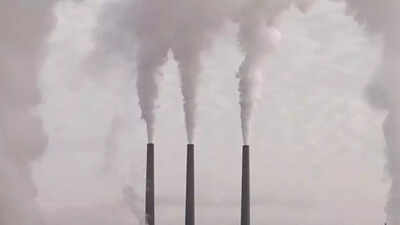- News
- City News
- lucknow News
- Intermittent rain lowers air pollution level in the city
Trending Topics
Intermittent rain lowers air pollution level in the city

Image used for representational purpose only
LUCKNOW: All thanks to back-to-back thunderstorms and rain in April and May which made this pre-monsoon air less polluted as compared to last year, revealed CSIR-Indian Institute of Toxicology Research (IITR) pre-monsoon assessment of ambient air quality of Lucknow released on the eve of World Environment day on Sunday.
However, the report highlighted that an increase in fuel consumption which ultimately leads to the worsening of air quality is a cause to worry and hence air pollution control measures should be adopted with immediate effect. The IITR team carried out the assessment of the city's air quality in nine localities, including four locations each in residential and commercial areas and one industrial location.
The report said that in all localities an increase in the air pollution was witnessed with PM 10 and PM 2.5 concentrations 30 and 21% more than the limits prescribed by the National Ambient Air Quality Standards. The average concentration of PM 10 and PM 2.5 in the city was 130.1 and 72.6 micrograms per cubic metre of air respectively.
However, in comparison to last year in residential, commercial, and industrial sites the levels of PM10 decreased by 11.8%, 20.3%, and 18.1%, and the levels of PM2.5 decreased by 12.6%, 27.8%, and 17.4% respectively. Similarly, overall in the city, the levels of SO2 and NO2 also decreased by 6.5 % and 11.5 % respectively from 2022 to 2023 during pre-monsoon. "The intermittent and scattered rainfall in different places of the city during the study period significantly influenced the suppression of the ground-level dust and settled down the suspended particles in the atmosphere. The rainy days also controlled some urban activities like vehicular movements and construction activities in the city which impact the air pollution levels," said an IITR scientist.
He said that in the survey it was found that the consumption of petrol, diesel and CNG increased by 23.7%, 24.9 and 22.2% respectively, while LPG consumption decreased by 32.4% by 2022-23 which is one of the main factors behind bad air quality. Apart from it increased levels of energy use, greater motorization and traffic, industrialization, building, and road dust as well as other increased household activities as a result of growing urban populations also contributed to bad air quality.
In residential areas Aliganj and in commercial areas Chowk were the most air-polluted localities where both PM 10 and PM 2.5 levels were above the permissible limits of 100 and 60 respectively.
However, the report highlighted that an increase in fuel consumption which ultimately leads to the worsening of air quality is a cause to worry and hence air pollution control measures should be adopted with immediate effect. The IITR team carried out the assessment of the city's air quality in nine localities, including four locations each in residential and commercial areas and one industrial location.
The report said that in all localities an increase in the air pollution was witnessed with PM 10 and PM 2.5 concentrations 30 and 21% more than the limits prescribed by the National Ambient Air Quality Standards. The average concentration of PM 10 and PM 2.5 in the city was 130.1 and 72.6 micrograms per cubic metre of air respectively.
However, in comparison to last year in residential, commercial, and industrial sites the levels of PM10 decreased by 11.8%, 20.3%, and 18.1%, and the levels of PM2.5 decreased by 12.6%, 27.8%, and 17.4% respectively. Similarly, overall in the city, the levels of SO2 and NO2 also decreased by 6.5 % and 11.5 % respectively from 2022 to 2023 during pre-monsoon. "The intermittent and scattered rainfall in different places of the city during the study period significantly influenced the suppression of the ground-level dust and settled down the suspended particles in the atmosphere. The rainy days also controlled some urban activities like vehicular movements and construction activities in the city which impact the air pollution levels," said an IITR scientist.
He said that in the survey it was found that the consumption of petrol, diesel and CNG increased by 23.7%, 24.9 and 22.2% respectively, while LPG consumption decreased by 32.4% by 2022-23 which is one of the main factors behind bad air quality. Apart from it increased levels of energy use, greater motorization and traffic, industrialization, building, and road dust as well as other increased household activities as a result of growing urban populations also contributed to bad air quality.
In residential areas Aliganj and in commercial areas Chowk were the most air-polluted localities where both PM 10 and PM 2.5 levels were above the permissible limits of 100 and 60 respectively.
Start a Conversation
FOLLOW US ON SOCIAL MEDIA
FacebookTwitterInstagramKOO APPYOUTUBE







